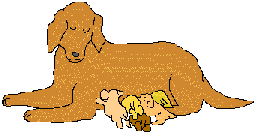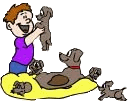  Each daily session involves handling the puppies once each day. We implement the program twenty-four hours after birth. The process requires handling the puppies one at a time while performing the series of five exercises. These five exercises will produce neurological stimulations, none of which naturally occur during this early period of life. The handler completes the series from beginning to end before starting with the next puppy. The handling of each puppy once per day involves the following exercises ~ 1. Tactical stimulation (between toes)
Five benefits have been observed in canines that were exposed to the Bio Sensor stimulation exercises. The benefits noted were: 1. Improved cardiovascular performance (heart rate) In tests of learning, stimulated pups were found to be more active and  by Dr. Carmelo L. Battaglia, PHD. Dr. Battaglia is a behavioral scientist and researcher whose writings and lectures are well known throughout the world of purebred dogs. His seminars and lectures on "Breeding Better Dogs" parallel his popular book and video by the same title. While we wholeheartedly endorse "Early Neurological Stimulation", we feel we must caution you that ENS is NOT for the novice. It is possible to over-stimulate. The book is a "MUST READ" for any breeder that is serious about breeding the best puppies possible. It is also a must that a breeder be properly trained in the technique.
|





